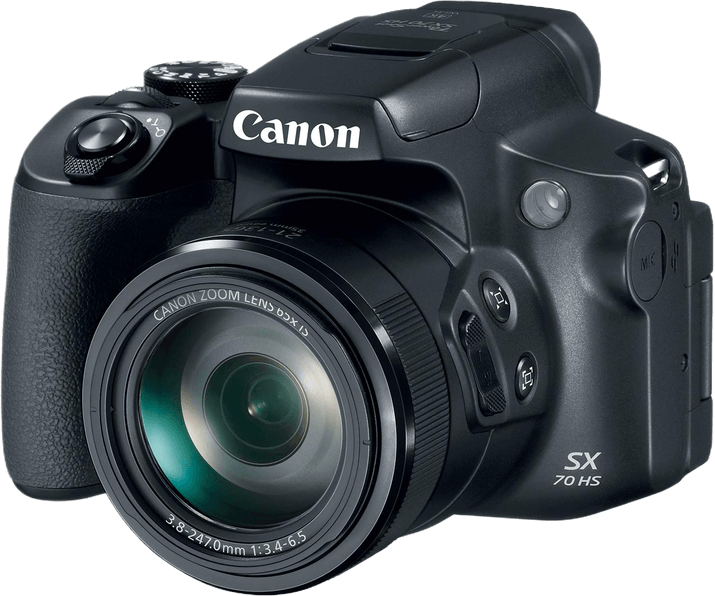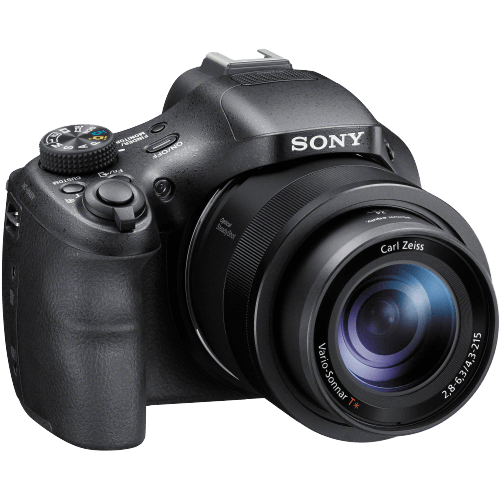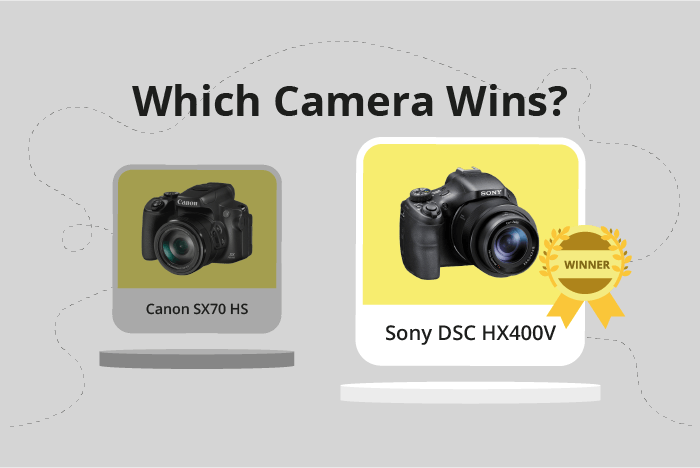Canon PowerShot SX70 HS vs Sony Cyber-shot DSC HX400V Comparison
Canon PowerShot SX70 HS

Sony Cyber-shot DSC HX400V

The Sony Cyber-shot DSC HX400V outperforms the Canon PowerShot SX70 HS with a score of 59/100 compared to 49/100. Both cameras share the same bridge type and have similar dimensions: the Canon measures 127 x 91 x 117mm and weighs 608g, while the Sony measures 130 x 93 x 103mm and weighs 660g.
The Sony HX400V excels with its lower launch price of $499 compared to the Canon’s $549. Despite being an older model, released in 2014, it still maintains a higher score. On the other hand, the Canon SX70 HS, released in 2018, has a more compact design and is lighter, offering easier portability.
Taking into account the specifications and scores, the Sony HX400V proves to be a better choice for those seeking a more affordable and higher-scoring bridge camera, while the Canon SX70 HS offers a more recent release with a slightly more convenient design.
Canon PowerShot SX70 HS vs Sony Cyber-shot DSC HX400V Overview and Optics
The Sony Cyber-shot DSC HX400V emerges as the winner in the optics comparison with a score of 64/100, outperforming the Canon PowerShot SX70 HS which scored 49/100. Both cameras share common specifications, including 20-megapixel resolution, 10 fps shooting speed, CMOS sensor type, 1/2.3″ sensor size, and a fixed lens mount.
The Sony HX400V has a superior DXOMARK sensor score of 82, compared to the Canon SX70 HS’s score of 58, indicating better overall sensor performance. The image stabilization feature in the Sony HX400V also contributes to its higher score, as it helps reduce camera shake and blur, especially in low light conditions. Additionally, the Sony HX400V uses a Bionz X processor, which provides faster processing and better noise reduction compared to the Digic 8 processor in the Canon SX70 HS.
In contrast, the Canon SX70 HS has a 3:2 aspect ratio, which is more versatile for different types of photography, such as landscape and portrait, compared to the 4:3 aspect ratio found in the Sony HX400V. However, this advantage is not substantial enough to outweigh the benefits provided by the Sony HX400V’s superior sensor performance and image stabilization.
Considering these factors, the Sony Cyber-shot DSC HX400V is the better choice in terms of optics, as it offers improved sensor performance and image stabilization, resulting in higher image quality. The Canon PowerShot SX70 HS does have a more versatile aspect ratio, but this advantage is not significant enough to surpass the overall performance of the Sony HX400V.
Canon PowerShot SX70 HS vs Sony Cyber-shot DSC HX400V Video Performance
The Canon PowerShot SX70 HS outperforms the Sony Cyber-shot DSC HX400V in video capabilities, scoring 91 out of 100 compared to the Sony’s 56. Both cameras share some similar specifications, but the Canon ultimately offers more advanced features.
Both the Canon and Sony cameras provide high-definition video recording. However, the Canon PowerShot SX70 HS has a maximum video resolution of 4K (3840 x 2160), while the Sony Cyber-shot DSC HX400V only offers Full HD (1920 x 1080). This means that the Canon camera can capture significantly more detail in its video recordings.
The Canon PowerShot SX70 HS also has a higher maximum video frame rate of 120fps, compared to the Sony Cyber-shot DSC HX400V’s 60fps. This allows the Canon camera to produce smoother slow-motion video footage. Additionally, the Canon PowerShot SX70 HS includes built-in time-lapse functionality, which is absent in the Sony Cyber-shot DSC HX400V. This feature enables users to create stunning time-lapse videos directly within the camera.
Despite its lower score, the Sony Cyber-shot DSC HX400V still offers quality Full HD video recording at 60fps. This is sufficient for many users who do not require the advanced video capabilities of the Canon PowerShot SX70 HS.
In comparing the video capabilities of these two cameras, the Canon PowerShot SX70 HS clearly surpasses the Sony Cyber-shot DSC HX400V with its 4K resolution, higher frame rate, and built-in time-lapse functionality. However, the Sony Cyber-shot DSC HX400V remains a viable option for those who prioritize other features or do not need the advanced video capabilities offered by the Canon camera.
Canon PowerShot SX70 HS vs Sony Cyber-shot DSC HX400V Features and Benefits
The Canon PowerShot SX70 HS and the Sony Cyber-shot DSC HX400V both score 54 out of 100 points in the features category, making it a tie. Both cameras have a 3-inch screen, with the SX70 HS having a resolution of 922,000 dots and the HX400V having a resolution of 921,600 dots. Additionally, both cameras have a flip screen and Wi-Fi capabilities.
The Canon PowerShot SX70 HS stands out with its Bluetooth connectivity, which the Sony Cyber-shot DSC HX400V lacks. This feature allows for easy pairing with compatible devices for seamless file transfer and remote control. However, the SX70 HS does not have a touchscreen or GPS functionality.
On the other hand, the Sony Cyber-shot DSC HX400V boasts a touchscreen interface, providing more intuitive control and navigation. It also has GPS capabilities, which can be useful for geotagging and tracking locations. Despite these advantages, the HX400V does not have Bluetooth connectivity.
To sum up, both cameras share similarities in screen size, resolution, flip screen, and Wi-Fi features. The Canon PowerShot SX70 HS excels with its Bluetooth connectivity, while the Sony Cyber-shot DSC HX400V outperforms with its touchscreen and GPS features. The choice between these cameras depends on the user’s preferences and priorities, whether it is Bluetooth connectivity or touchscreen and GPS functionality.
Canon PowerShot SX70 HS vs Sony Cyber-shot DSC HX400V Storage and Battery
The Sony Cyber-shot DSC HX400V outperforms the Canon PowerShot SX70 HS in storage and battery with a score of 29/100, compared to the Canon’s 21/100. Both cameras have one memory card slot and accept SD, SDHC, and SDXC cards. However, the Sony HX400V also accepts Memory Stick Duo, Memory Stick Pro Duo, and Memory Stick Pro-HG Duo cards, offering more storage options.
The Canon SX70 HS has a slightly better battery life at 325 shots, while the Sony HX400V offers 300 shots. The Canon uses an LP-E12 battery, while the Sony uses an NP-BX1 battery. Despite its lower battery life, the Sony HX400V has the advantage of USB charging, which the Canon SX70 HS lacks.
Considering the storage and battery aspects, the Sony HX400V offers more versatility in storage options and the convenience of USB charging. The Canon SX70 HS, on the other hand, has a marginally better battery life. Taking these factors into account, the Sony HX400V is the superior choice in terms of storage and battery capabilities.
Canon PowerShot SX70 HS vs Sony Cyber-shot DSC HX400V – Our Verdict
Are you still undecided about which camera is right for you? Have a look at these popular comparisons that feature the Canon PowerShot SX70 HS or the Sony Cyber-shot DSC HX400V:
- Canon PowerShot SX70 HS vs Panasonic Lumix DMC-FZ2000 / FZ2500
- Canon PowerShot SX70 HS vs Nikon Coolpix B500
- Canon PowerShot SX70 HS vs Panasonic Lumix FZ80 / FZ82
- Sony Cyber-shot DSC HX400V vs Cyber-shot RX10 IV
- Canon PowerShot SX70 HS vs PowerShot SX740 HS
- Nikon Coolpix B500 vs Sony Cyber-shot DSC HX400V

